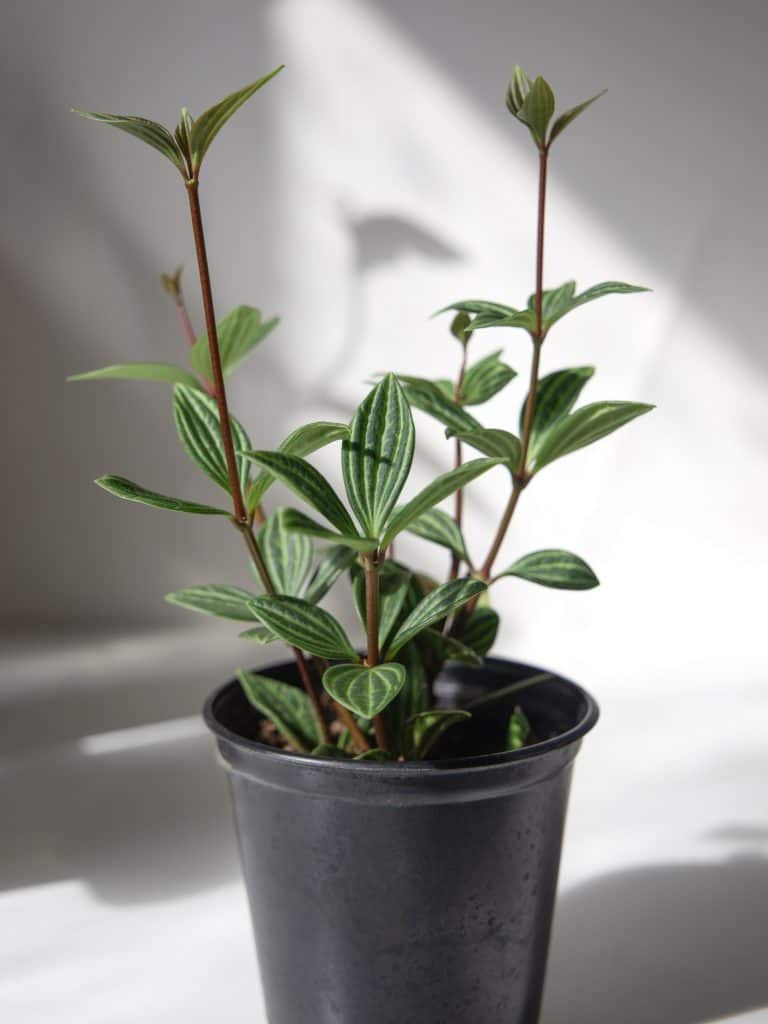| Common Name(s) | Peperomia Beetle and Radiator Plant and Peperomia Angulata |
| Scientific Name | Peperomia Quadrangularis |
| Sun Exposure | Partial/filtered sunlight |
| Soil pH | pH level between 5.5 and 6.5 |
| Watering Requirement | Regular watering |
| Hardiness Zone | 11-12 |
| Plant Height | 12 inches |
Peperomia Quadrangularis is a small plant hailing from South Africa originally, but can now be found in places like Panama and Brazil due to the plant’s love of humidity. The leaves of a Peperomia Quadrangularis resemble a watermelon, with large deep green stripes between smaller lighter stripes. These plants have a lot in common with succulents, but require much more water and humidity.
The Peperomia Quadrangularis plant is low maintenance and can thrive both indoors and out as long as they are kept out of direct sunlight. Due to their small size, they are quite popular indoor plants and can be in a regular pot or on display in a hanging planter once mature enough for the limbs to hang over.
Peperomia Quadrangularis Care
Peperomia Quadrangularis are easy to care for. They need partial shade or filtered sun, as they do not do well in direct or constant sunlight, though some sun is a must. As they require only partial sunlight, a perfect spot in a home would be on a windowsill. To thrive in an outdoor setting, Peperomia Quadrangularis would need to be nestled in amongst other plants to give them cover, or on the side of a house so that they receive shade for a good portion of the day.

When it comes to soil, the Peperomia Quadrangularis needs a mix that will allow for drainage and a pH of 5.5 to 6.5. In nature, this plant can be found growing on trees or even in the crack of a stone. This is a clue to the kind of soil this plant requires. Not surprisingly, aeration is key. Some mulch and perlite blended into a store-bought succulent mix with some home-made compost will do the Peperomia Quadrangularis good. The perlite helps with aeration while the compost acts as a fertilizer.
Like all living things, the Peperomia Quadrangularis needs water. The soil should be kept damp, but be careful not to over water. At no time should there be standing water or so much water that it cannot be absorbed by the soil in the pot. To help prevent overwatering, a pot with good drainage is a must and to hedge your bets even further, some gravel at the bottom of the pot would not hurt.
The Peperomia Quadrangularis thrives in a humid climate, so misting is required to mimic this if you do not live in a naturally humid area or if you are growing your Peperomia Quadrangularis indoors. Light misting should be done every few days.
The hardiness zones for Peperomia Quadrangularis plants are zones 11 and 12. Their ideal temperature range is 60°F to 75°F, but they can withstand a little variation. This said, if the temperature drops below 50°F, it is best to move your Peperomia Quadrangularis indoors to avoid damage. Similarly, if the heat index is too high, you can bring the plant inside, or move it to a shadier area and make sure to check that the soil is not drying out quicker due to the heat. If this is happening, adjust your watering and misting accordingly.
When it comes to fertilizer, the Peperomia Quadrangularis is low maintenance. During the growing months it is advisable to fertilize about once a month, which means during winter, you can leave the plant to its own devises. When fertilizing, a homemade compost or some liquid fertilizer will do. This plant does not do well with harsh chemicals, so organic fertilizers are recommended.
Let’s talk about how to propagate a Peperomia Quadrangularis properly. Cut away a healthy leaf with the stalk attached. Then cut away the actual leaf. Next, place the remaining stalk in some moist, warm soil. Last, place in a sunlit area and await your new Peperomia Quadrangularis. Note that this must be done during the growing months.
Pruning is a part of caring for most plants. The low maintenance Peperomia Quadrangularis only requires the bare minimum when it comes to pruning. If you see a dying leaf or stem, go ahead and remove it, but outside of that, the plant does not require any other kind of trimming.
The Peperomia Quadrangularis is a slow growing plant that stays relatively small. On average, these plants grow to about 12 inches. As they are trailing plants, they are well suited for hanging planters once they have grown to maturity. Their small stature also makes them great desk plants. Since their root systems are small, they do not require too much room when it comes to pot size and can make a lovely accent to the home without taking up too much space.

Do Peperomia Quadrangularis plants flower?
A properly cared for Peperomia Quadrangularis can flower during spring and summer. The flowers do not look like the typical flowers we would picture when someone says the word “flower”. This plant’s flowers are thin, spikey, and white, protruding from the plant at random intervals. Some plants, like certain species of roses, require what is called “deadheading” to promote growth. Luckily, the flowers of a Peperomia Quadrangularis will eventually fall off on their own and do not require removal.
Problems Growing Peperomia Quadrangularis
Common problems with Peperomia Quadrangularis include root rot, drooping leaves, brown spots, and leaves curling. The most common of which being root rot, which is caused by over watering and insufficient drainage. If your plant does contract root rot, all hope is not necessarily lost. In most cases, the plant can be salvaged by washing off the roots and then repotting the healthy section of roots in new soil and backing off on watering.
Droopy leaves are most often a sign of overwatering. So, if your plant looks like it needs a face lift, the first thing to try is to give the watering a bit of a rest and see if your plant perks up.
If your Peperomia Quadrangularis’ leaves start curling, it is a little harder to identify the cause and may take some trial and error. Curling leaves could mean your plant is being underwatered, but it could also be a sign of overwatering, the plant being too hot, or the humidity being too low.
Brown spots usually mean your Peperomia Quadrangularis is getting too much sun, but like curly leaves, can also be a sign of over or underwatering. The spots could alternatively be a sign of disease, pests, abrupt climate changes like humidity or temperature drops, or a fertilizer issue. Since our plants cannot tell us what the problem is, you’ll have to use your best problem-solving skills to figure out what has your Peperomia Quadrangularis browning.
Where can I find Peperomia Quadrangularis for sale?
Peperomia Quadrangularis are not hard to find. They are sold online on sites like Amazon and Etsy and can be found in stores at places like Lowes. These plants are inexpensive and can range from $15 to $25 depending on the size and seller.
Are Peperomia Quadrangularis Toxic to Pets?
These plants are not toxic. Meaning both cats and dogs will be alright if they happen to ingest the Peperomia Quadrangularis plant.
Peperomia Quadrangularis vs Peperomia Angulata
If you were given these two to compare on a test, it would be a trick question. Peperomia Angulata is actually another name for Peperomia Quadrangularis. The Peperomia Quadrangularis also goes by Peperomia Beetle and Radiator Plant. The nickname Radiator Plant is pretty accurate when you take into account that this plant thrives in warm, tropic climates.
Peperomia Quadrangularis vs Dischidia Ovata
On the surface, these two plants are very similar. Both have leaves that resemble watermelons, they like humidity, have shallow root systems and are susceptible to root rot. But, at a closer look, these plants are not identical twins.
The Dischidia Ovata’s leaves have stripes that are white with distinct veins coming off them, whereas the leaves of a Peperomia Quadrangularis have yellow stripes and smaller, less distinct veins bleeding into the dark green.
These plants come from two completely different families and are even classified as different types of plants. The Peperomia Quadrangularis is part of the Piperaceae family, while the Dischidia Ovata is of the Apocynaceae family. The Peperomia Quadrangularis is classified as a shrub, while the Dischidia Ovata is classified as a vine. These two plants would be a prime example of not judging a book by its cover.
As mentioned previously, the flowers from the Peperomia Quadrangularis are thin and spiky, while the flowers produced by the Dischidia Ovata resemble bells or bulbs. The bells are yellow with purple stripes, a stark contrast to the white of a Peperomia Quadrangularis flower.
It is crucial you identify your plant correctly, because these two plants may look alike, but their care differs. The Dischidia Ovata needs to dry out between waterings, as opposed to the Peperomia Quadrangularis, which needs to be kept moist. Confusing these two’s treatment could mean damage for either plant.
